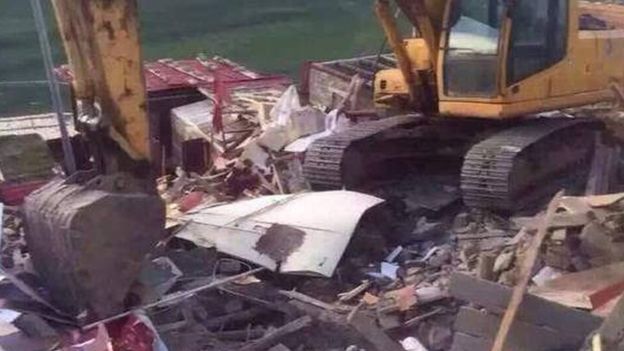 The horror began with the Chinese invasion of Tibet in 1949. In the decades since, Chinese oppression has continued relentlessly, with several hundred thousand Tibetans having been executed, tortured or imprisoned.
The horror began with the Chinese invasion of Tibet in 1949. In the decades since, Chinese oppression has continued relentlessly, with several hundred thousand Tibetans having been executed, tortured or imprisoned.
Commenting after her recent release, one survivor informs us that “Chinese officials used different torture instruments on me to break my spirit…to make me denounce his Holiness and the aspirations of my people. My fellow political prisoners and I were subjected to electric shocks from batons and prods…I spent weeks in solitary confinement. This torture and mistreatment started when I was just a child of thirteen and continued through most of my life in prison.”
I knew that the Chinese regime had signaled out Buddhists in Tibet to denigrate its culture as one effort among others to suppress their identity and, with it, their desire to be a free people.
Of an original 6,254 monasteries that existed before the Chinese invasion, just 13 remain fully intact, the others either destroyed or severely damaged.
A few days ago, I finished reading Stephen Batchelor’s fascinating book, Confessions of an Atheist Buddhist. Batchelor had converted to Buddhism as a young man and was formally ordained as a monk in 1974, and knows both the Tibetan language well and the woes of Buddhism, Tibet’s ancient faith.
He recalls visiting Lhasa in 1984. While the Potala Palace remains, it’s now a museum. Few traces of Buddhism, in fact, remain in this city once filled with Buddhist shrines and ubiquitous prayer flags.
From the Potala, you can glimpse what remains of the nearby Sera Monastery. 3000 monks lived there in 1959, the year of the Tibetan uprising. Now, only 100 lamas remain, all of them elderly.
Twenty miles east of Lhasa lies the Ganden Monastery, founded in the 14th century. Sadly. the infamous Red Guards ordered the local people to dismantle it, stone by stone. Once the residence of some 5,000 monks, only a scattering of aged monks remains.
Chinese persecution of Tibetan Buddhists continues unabated even beyond Tibet proper. In June 2016, the PRC mandated that half of the world’s largest Buddhist conclave, the Tibetan Buddhist Institute at Larung Gar, with its estimated 40,000 monks and nuns in Szechuan, be razed and its numbers reduced to 3,500 nuns and 1500 monks.
According to Radio Free Asia, expelled monastics must sign a pledge to “uphold the unity of the nation and not to engage in behavior opposing government policy in the area.”
Last month (December 6, 2016), the Tibetan government-in-exile asked the UN to intervene.
Meanwhile, the European Parliament on December 15, 2016, adopted a resolution condemning the destruction of the community.
Here at home, President Obama hosted Tibet’s spiritual leader, the Dalai Lama in both 2010 and 2014, giving verbal support for the preservation of Tibet’s culture, while subsequently restating the U. S. position that Tibet is part of the People’s Republic of China. (He did not meet with the Dalai Lama in the Oval Office.)
China views the Dalai Lama as a separatist, however, and hence a threat to government hegemony, even though the Dalai Llama has never advocated independence..
Meanwhile China is pressing forward with resettling thousands of Chinese in Tibet and plans to build a second railway into the country to expedite commerce and tourism in particular.
Since 1990, China has relocated more than 2 million nomads into barrack settlements under the guise of protecting grazing land.
 In urban areas, new schools are being built with Mandarin the primary language of instruction.
In urban areas, new schools are being built with Mandarin the primary language of instruction.
Though most of Tibet remains overwhelmingly Tibetan, an estimated 17% of Lhasa’s population is now Chinese.
In short, the Chinese have been following the Soviet formula of resettling volatile areas such as Ukraine, Lithuania, Latvia and Estonia, where a large Russian population now resides.
There are a few Westerners who argue that reports of Chinese repression have been exaggerated.
I have more faith in Amnesty International, which relies upon documentary evidence. In its 2014 report, it concluded that “ethnic Tibetans continued to face discrimination and restrictions on their rights to freedoms of religious belief, expression, association and assembly.”
We are now into 2017, and while the world largely goes its own way, Tibet’s fate continues to deter towards extinction of its culture as the Chinese People’s Republic recent ordnance demolishing Larung Gar clearly demonstrates in its strident callousness.
Since 2011, American International has documented 131 self-immolations in protest of Chinese incursions upon its way of life.
—rj

McAfee gave me a Whoa! warning for this post. It was ranked Medium Risk.
Politics, of certain kinds, apparently….
LikeLike
I think you could say that millions have been killed.
LikeLike
We’ll never know, but you may be right.
Sent from my iPhone
>
LikeLike